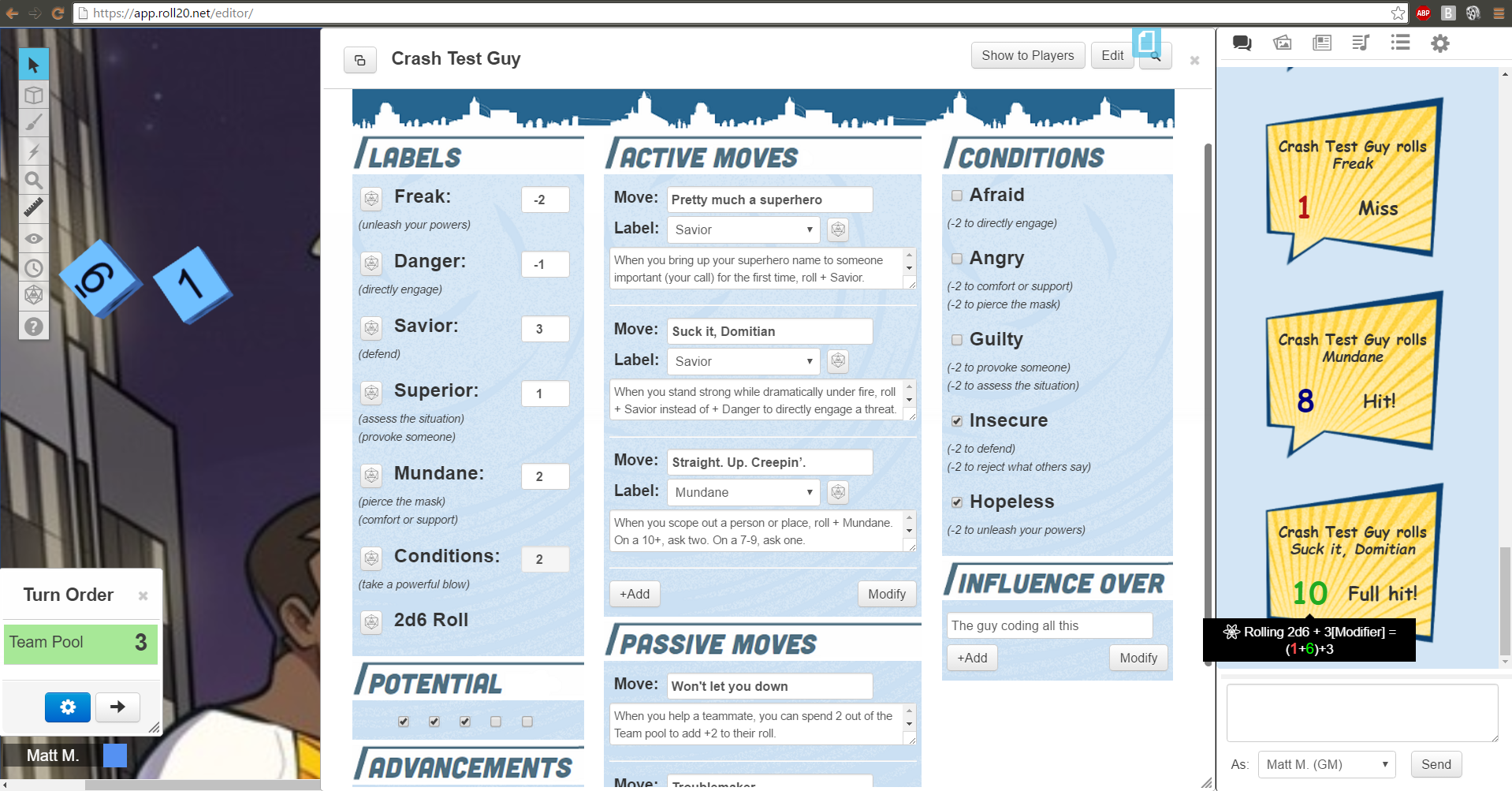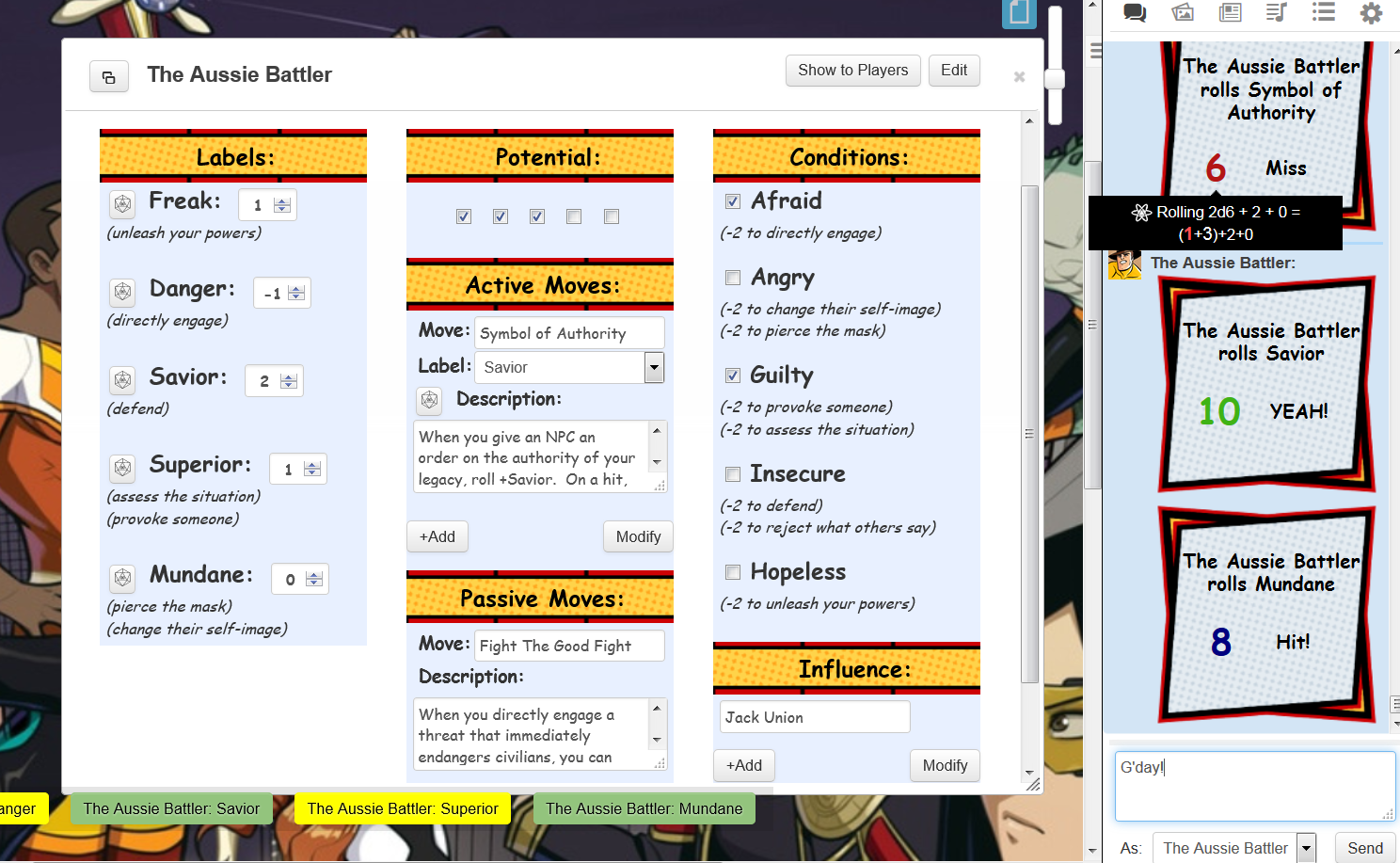This started out as a reply to the discussion between Danielle Hohensee and co, but got crazy long and went on a bit…
This started out as a reply to the discussion between Danielle Hohensee and co, but got crazy long and went on a bit of a tangent. But since the topic is one I’ve seen come up a few times amongst my own groups as well as here on G+ (including a bit in that discussion by Doyce Testerman that’s exploded into a jillion comments while I was sleepin’!) I figured I’d make it its own thing so as to not derail that thread.
The topic at hand: Unleash Your Powers as a blasting-bad-guys combat move, and its use compared & contrasted to Directly Engage. The when and how of inflicting Conditions is an adjacent topic, but also distinct from this one in its own ways, so I’m not touching on it (yet).
Open discussion! Agree, disagree, caveat, food for thought, personal experiences, all of the above; I spiel like I know what I’m talking about but mostly I’m just brainstorming out-loud about how the game works in the absence of a full rulebook, ’cause having to write it out helps me nail down what I actually think about stuff.
Unleash Your Powers, as I see it, is a creative problem-solver, and only used for fighting-type stuff as a last resort. It’s a toolbox, not a weapon. Primarily, it enacts change in the situation; the examples in the original thread of shutting down shields or knocking things around are spot-on. It creates barriers, melts stuff, moves things (including yourself), and lets you do lots of other creative stuff with your powers other than blasting dudes. The key to it (and most moves in Masks, I’ve found) is looking at what it straight-up says you’re doing coupled with the 7-9 results. Particularly in the case of Unleash, “you do it” and “miss” at either end of the spectrum don’t give much context to anything, so 7-9 is where you wanna focus. Then if you’re not doing one of the actions described, or you can’t think of how the result would be stressful (marking a Condition), unstable or temporary, it’s probably not a situation you should be Unleashing in to begin with. This move’s applications are quite vague — by design I’m pretty sure — and if you get creative with it you can make the rules apply to a lot of different situations, meaning it’ll often overlap with another move (when Daredevil does his thing, is he “extending his senses” or “assessing a situation”?). A lot of the time I tend to process-of-elimination it by looking at the other moves that might apply and seeing if they do, falling back to Unleash as a backup plan if other things don’t seem to fit.
On that note, with this combat-ruling discussion, the key points of Directly Engage are that it’s versus a threat and that you trade blows. So the only real criteria for it to come into play is that you’re trying to hit someone where it hurts — could be physically, or emotionally, or psychologically, or… spiritually? — and they’re willing and able to hit you back, too. Other considerations like range or the powers involved don’t really matter, as long as those two things are true. For example, having a fist fight can obviously be Directly Engaging, but so can having a bitter argument with someone over the phone; you’re just trading emotional or psychological blows instead of physical ones.
In a more superpowered Nova-type example, flying 500 feet above a group of evil henchmen and raining fireballs on them is still Directly Engaging (and potentially Reality Storming) as long as they’re aware of you and are shooting their evil laser rifles back up at you, or can otherwise threaten you. If they’re aware of you but can’t really do much about it, they’re not a threat to you, and so the situation doesn’t fit the Directly Engage criteria.
If that’s the case (or they’re not aware of you and you’re just raining hellfire on them out of the blue like a superpowered stealth bomber) it’s up to the GM to call it based on the situation. I think a lot of GMs would want a roll of some kind and rule it as an Unleash, though the broadness of that move makes the 7-9 results a bit awkward to play out without some creativity (feel Guilty for setting a bunch of people on fire? temporarily set them on fire/scatter/suppress them? interpret “unstable” as “uncontrolled” and have some collateral happen?). Personally, if you were completely blindsiding some guys like that, I probably wouldn’t even call a roll; I’d just let it happen and move on. Good job leveraging your strengths, hero, let’s play to find out what changes. 
On the flip side, let’s say your friend the Bull is on the ground with the mass of laser-rifle-toting goons, and he likes to get up close and personal. The faceless henchmen are aware of him, and they have numbers and laser rifles, but it doesn’t matter because this guy’s invulnerable skin eats lasers for breakfast and his immense super strength means they’d struggle to even restrain him — meaning, in the scenario I’ve presented, he’s not going to bat an eye at anything they can throw at him and so despite him punching them in their stupid evil faces, Directly Engage wouldn’t apply, because there’s no threat. If he does just want to start punching these jerks out, he probably either just can without a roll (again, GM call) or he could be reshaping his environment to have way less conscious laser henchmen in it, thus rolling an Unleash with similarly-awkward 7-9 results, as above.
(Note that if the goons could slow him down with their numbers and other objectives were at stake, he could be under threat of wasting time and Directly Engage would be back on the menu, but I’mma keep it simple).
The real question, however, both fictionally and mechanically isn’t what he’s doing but why he’s doing it. Punching dudes is fine, and if that’s all that matters in the situation, see above. But if his purpose for it is to cause a ruckus and distract them so that your flying Nova self doesn’t get shot out of the sky, he’s Defending you (with his fists!) despite you being 500 feet skyward. Or he could be making a big show of how laughably-easy thumping the goon squad is in order to Provoke their villainous leader into a rash course of action. Or if he’s just trying to punch a path through the henchmen in order to reach said villain, that’s a pretty clear Unleash with the Bull trying to overcome an obstacle. And when he gets there, maybe the big bad villain can physically harm him, or has enough presence to hit him where it hurts in his sentimental Bull heart, in which case when those two square off he’s finally, clearly Directly Engaging in the traditional facepunch sense.
So, basically, like everything else in Masks, I feel like it’s down to context. When my player says “I want to blast that dude with fireballs”, I ask to what end — to open the door for it being a variety of situationally-appropriate moves — and if it’s just in the vein of “because I want him to go down” then Directly Engage gets the first look. But if the criteria for it don’t fit, because there’s no threat one way or the other… unless I feel a pressing need to introduce the possibility of failure, maybe we don’t touch the dice at all, ’cause Unleash isn’t really built for straight-up fighting, at any range. And if the heroes do find themselves in a situation where they can engage bad guys without being threatened, getting what amounts to an auto-success shouldn’t be able to derail a scene anyway, because those 10+ results were on the cards already. And if that foils my villainous plans, well, there’s always next time (Gadget!).






